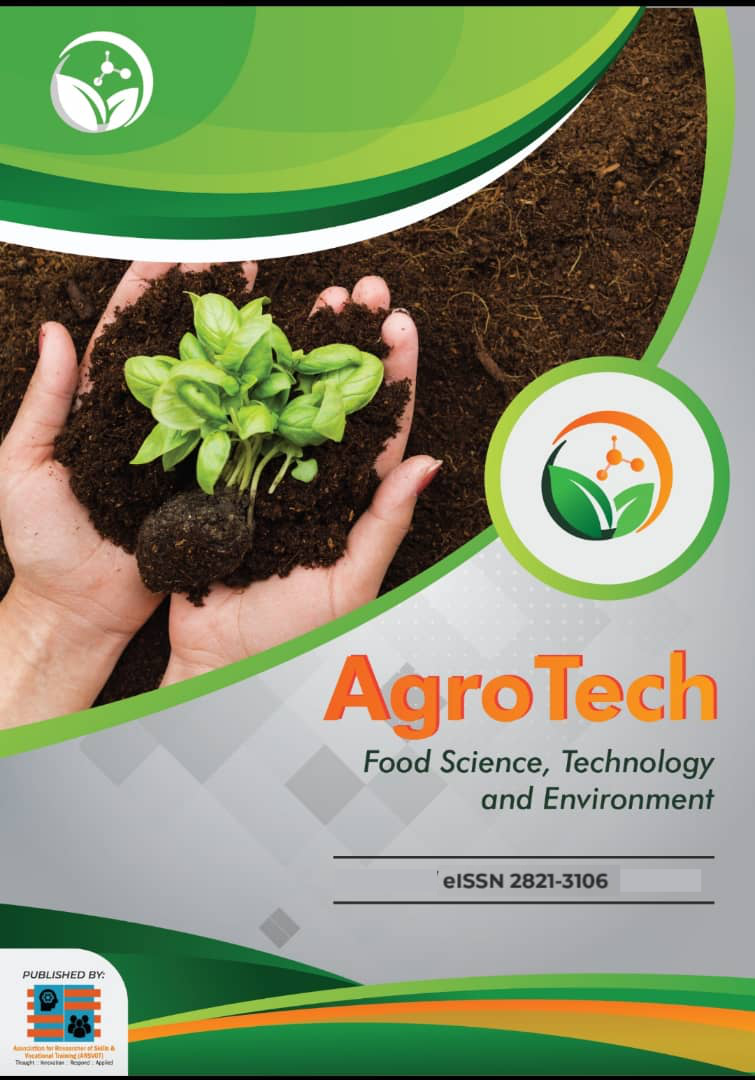Effects of Salinity on the Growth of Eggplant (Solanum melongena L.)
DOI:
https://doi.org/10.53797/agrotech.v2i1.10.2023Keywords:
salinity, eggplant, growth parameters, Solanum melongena L., tolerance thresholdAbstract
This study investigated the effects of varying salinity levels on the growth performance of eggplant (Solanum melongena L.). Four treatments were applied: control (0.03 ppt), low salinity (3 ppt), moderate salinity (6 ppt), and high salinity (9 ppt). The experiment was conducted over five months under rain-shelter conditions at Universiti Pendidikan Sultan Idris, employing a Randomized Complete Block Design (RCBD) with three replications and 60 plants in total. Growth parameters evaluated included plant height, canopy area, number of leaves, leaf surface area, and root length. Data were analyzed using ANOVA and LSD tests at a significance level of P ≤ 0.05. The results revealed that salinity significantly (P ≤ 0.01) affected all growth parameters. Plants exposed to higher salinity levels exhibited stunted growth and reduced biomass accumulation. The findings indicate that S. melongena can tolerate salinity up to 3 ppt, although mild growth inhibition may still occur. These results provide useful insights into the salinity tolerance thresholds of eggplant for future cultivation in saline-prone environments.
Downloads
References
Akinci, I. E., Akinci, S., Yilmaz, K., & Dikici, H. (2004). Response of eggplant varieties (Solanum melongena) to salinity in germination and seedling stages. New Zealand Journal of Crop and Horticultural Science, 32(2), 193–200. https://doi.org/10.1080/01140671.2004.9514292
Chaudhary, S., Kanwar, M. K., Bhardwaj, R., & Sharma, A. (2022). Salt stress and plant growth: Understanding mechanisms and strategies for crop improvement. Plant Stress, 3, 100067. https://doi.org/10.1016/j.stress.2021.100067
Daunay, M. C., Lester, R. N., & Gebhardt, C. (2021). Eggplant. In C. Kole (Ed.), Wild crop relatives: Genomic and breeding resources (pp. 295–313). Springer. https://doi.org/10.1007/978-3-642-21101-0_16
FAO. (2021). Global map of salt-affected soils. Food and Agriculture Organization of the United Nations. https://doi.org/10.4060/cb9918en
Frary, A., Doğanlar, S., Daunay, M. C., & Tanksley, S. D. (2007). Eggplant. In Genome Mapping and Molecular Breeding in Plants (pp. 231–257). Springer. https://doi.org/10.1007/978-3-540-34536-7_13
Hakim, M. A., Juraimi, A. S., Begum, M., Hanafi, M. M., & Ismail, M. R. (2010). The effect of salinity on growth, ion accumulation and salt tolerance of rice varieties. Australian Journal of Crop Science, 4(3), 169–174.
Hasanuzzaman, M., Nahar, K., Fujita, M., & Islam, M. T. (2021). Plant responses and tolerance to salt stress: Physiological and biochemical mechanisms. In M. Hasanuzzaman et al. (Eds.), Plant Abiotic Stress Tolerance (pp. 23–76). Springer. https://doi.org/10.1007/978-3-030-72803-0_2
Hasegawa, P. M., Bressan, R. A., Zhu, J. K., & Bohnert, H. J. (2000). Plant cellular and molecular responses to high salinity. Annual Review of Plant Biology, 51, 463–499. https://doi.org/10.1146/annurev.arplant.51.1.463
Heuer, B., Meiri, A., & Shalhevet, J. (1986). Salt tolerance of eggplant. Plant and Soil, 95(1), 9–13. https://doi.org/10.1007/BF02377105
Hossain, M. A., Uddin, M. K., Ismail, M. R., & Ashrafuzzaman, M. (2012). Responses of glutamine synthetase–glutamate synthase cycle enzymes in tomato leaves under salinity stress. International Journal of Agriculture and Biology, 14, 509–515.
Jeannette, E., Roubelakis-Angelakis, K. A., & Boyer, N. (2002). Salt stress and plant growth. In Pessarakli, M. (Ed.), Handbook of Plant and Crop Physiology (pp. 453–472). CRC Press.
Jha, U. C., Bohra, A., Jha, R., Chaturvedi, S. K., & Soren, K. R. (2023). Salt stress in crop plants: Understanding molecular mechanisms and potential breeding strategies. Frontiers in Plant Science, 14, 1117035. https://doi.org/10.3389/fpls.2023.1117035
Kashyap, V., Dhiman, M. R., Ram, R. B., & Srivastava, K. (2003). Evaluation of brinjal (Solanum melongena L.) germplasm under sodic soil conditions. Vegetable Science, 30(1), 76–78.
Kumar, N., Guleria, S., & Sharma, D. R. (2022). Eggplant (Solanum melongena L.): Nutritional composition and health benefits. Vegetos, 35, 1346–1354. https://doi.org/10.1007/s42535-022-00343-5
Maas, E. V. (1984). Salt tolerance of plants. In R. J. Hagan et al. (Eds.), Handbook of Plant Science in Agriculture (pp. 57–75). CRC Press.
Maathuis, F. J. M. (2006). The role of monovalent cation transporters in plant responses to salinity. Journal of Experimental Botany, 57(5), 1137–1147. https://doi.org/10.1093/jxb/erj117
Munns, R. (2002). Comparative physiology of salt and water stress. Plant, Cell & Environment, 25(2), 239–250. https://doi.org/10.1046/j.0016-8025.2001.00808.x
Munns, R. (2005). Genes and salt tolerance: bringing them together. New Phytologist, 167(3), 645–663. https://doi.org/10.1111/j.1469-8137.2005.01487.x
Munns, R., & Tester, M. (2008). Mechanisms of salinity tolerance. Annual Review of Plant Biology, 59, 651–681. https://doi.org/10.1146/annurev.arplant.59.032607.092911
Parida, A. K., & Das, A. B. (2005). Salt tolerance and salinity effects on plants: A review. Ecotoxicology and Environmental Safety, 60(3), 324–349. https://doi.org/10.1016/j.ecoenv.2004.06.010
Rengasamy, P. (2006). World salinization with emphasis on Australia. Journal of Experimental Botany, 57(5), 1017–1023. https://doi.org/10.1093/jxb/erj108
Roslan, Z. A., Ahmad, D., & Arifin, A. (2019). Climate change impact on coastal agriculture: The case of salinity intrusion and adaptation in Malaysia. IOP Conference Series: Earth and Environmental Science, 298, 012020. https://doi.org/10.1088/1755-1315/298/1/012020
Santa-Cruz, A., Martinez-Rodriguez, M. M., Perez-Alfocea, F., Romero-Aranda, R., & Bolarin, M. C. (2002). The rootstock effect on the tomato salinity response depends on the shoot genotype. Plant Science, 162(6), 825–831. https://doi.org/10.1016/S0168-9452(02)00038-8
Savvas, D., & Lenz, F. (1996). Influence of salinity on the incidence of blossom-end rot in tomato grown on rockwool. Journal of Horticultural Science, 71(3), 313–320. https://doi.org/10.1080/14620316.1996.11515313
Shrivastava, P., & Kumar, R. (2015). Soil salinity: A serious environmental issue and plant growth promoting bacteria as one of the tools for its alleviation. Saudi Journal of Biological Sciences, 22(2), 123–131. https://doi.org/10.1016/j.sjbs.2014.12.001
Unlukara, A., Kurunc, A., Kesmez, G. D., Yurtseven, E., & Suarez, D. L. (2010). Effects of salinity on eggplant (Solanum melongena L.) growth and evapotranspiration. Irrigation and Drainage, 59(2), 203–214. https://doi.org/10.1002/ird.491
Wu, X. X., Zhu, Z. W., Li, X. L., & Zuo, C. (2012). Effects of 24-epibrassinolide on photosynthesis of eggplant (Solanum melongena L.) seedlings under salt stress. Photosynthetica, 50(3), 389–396. https://doi.org/10.1007/s11099-012-0036-z
Zörb, C., Geilfus, C. M., & Dietz, K. J. (2019). Salinity and crop yield. Plant Biology, 21(S1), 31–38. https://doi.org/10.1111/plb.12884
Downloads
Published
How to Cite
Issue
Section
License
Copyright (c) 2023 arsvot

This work is licensed under a Creative Commons Attribution-NonCommercial-ShareAlike 4.0 International License.



